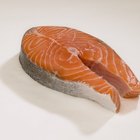ksena32/iStock/GettyImages
Brazilian pepper tree is the common name for the Schinus terebinthifolius tree, a native of Brazil, Argentina and Paraguay. Its incarnation in the United States is considered invasive in states such as California, Florida and Texas, with aggressive programs in place to eradicate it from natural ecosystems and disturbed habitats. Due to the presence of toxic compounds in the bark, Brazilian pepper tree wood should never be used for cooking.
Poisonous Smoke
Similar to poison ivy, poison oak and poison sumac, the leaves and bark of the Brazilian pepper tree contain urushiol, a toxic oil that causes serious rashes and allergic reactions. When the wood is burned for cooking or smoking foods, the toxic compounds become airborne and can cause severe reactions when they come into contact with eyes and skin. Inhaling the smoke can irritate and burn your throat, mouth and lungs, and contribute to respiratory illness. The smoke may settle into the fur of your pets and be absorbed into furniture, creating poisonous pockets in your environment.
Related Articles

Eucalyptus Oil & Acne

How to Make a Venison Rub

How to Smoke Salmon Fillets

How to Use Wood Chips in a Smoker

Grilling a Top Sirloin Filet in a Cast ...

How to Smoke Ribs With a Gas Smoker

How to Cook With a Brinkmann Barrel ...

Cooking Times for Smoking Meat in an ...

Health Risks of Marble Dust

How to Broil Filet Mignon Wrapped in ...

Jojoba Oil Benefits

How to Remove a Smoke Smell from a ...

Can Borage Oil Help Acne?

Herbs That Cause Photosensitivity

How to Clean Jalapeños

How to Pickle Brine Sausage

How to Smoke Hamburgers

How to Fry Liver

How to Roast Pork on a Weber Grill

How to Cook a Brisket in the Ground
References
Resources
Writer Bio
Wendy K. Leigh is a travel writer and photojournalist from Seattle. She is the Editor of Islands America, a travel website for visiting islands within the United States. She also writes about home design, food and historical architecture. Leigh holds a Bachelor of Arts in English from the University of Washington.